Report: Leadership and Management for Service Industries - Unit 5
VerifiedAdded on 2023/01/23
|16
|990
|80
Report
AI Summary
This report examines leadership and management within service industries, focusing on classical management theories, leadership styles, and organizational structure. It discusses scientific management, administrative theory, and organizational culture, including task, role, unitary, decentralized, centralized, divisional, and matrix structures. The report also explores the role of a leader in motivating manpower and building morale, alongside different management and leadership styles, relating physiological, social, safety, esteem, and self-actualization needs to leadership approaches such as democratic and autocratic styles. The report concludes by emphasizing the importance of leadership and management in achieving organizational goals and adapting to industry demands.
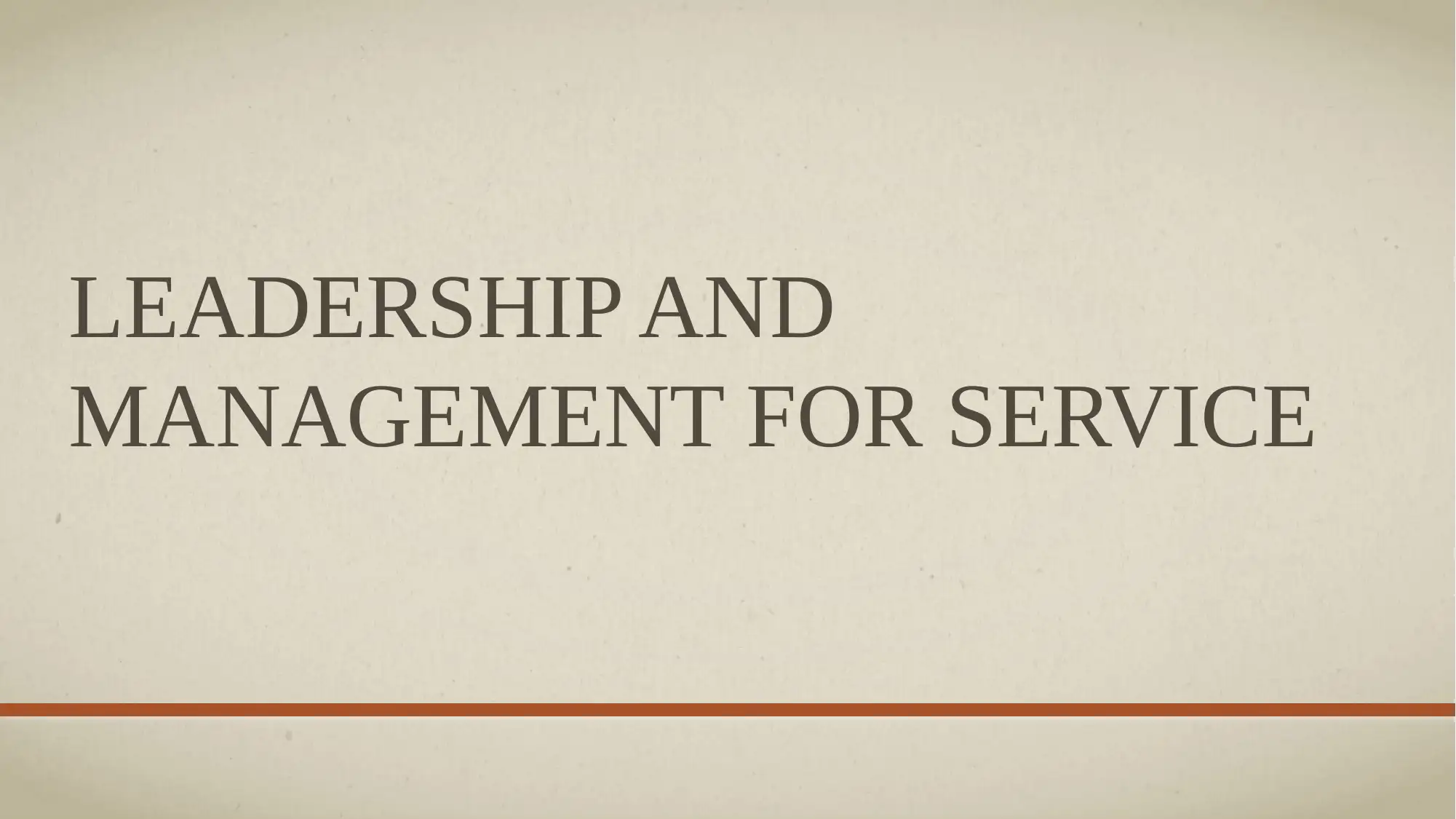
LEADERSHIP AND
MANAGEMENT FOR SERVICE
MANAGEMENT FOR SERVICE
Paraphrase This Document
Need a fresh take? Get an instant paraphrase of this document with our AI Paraphraser
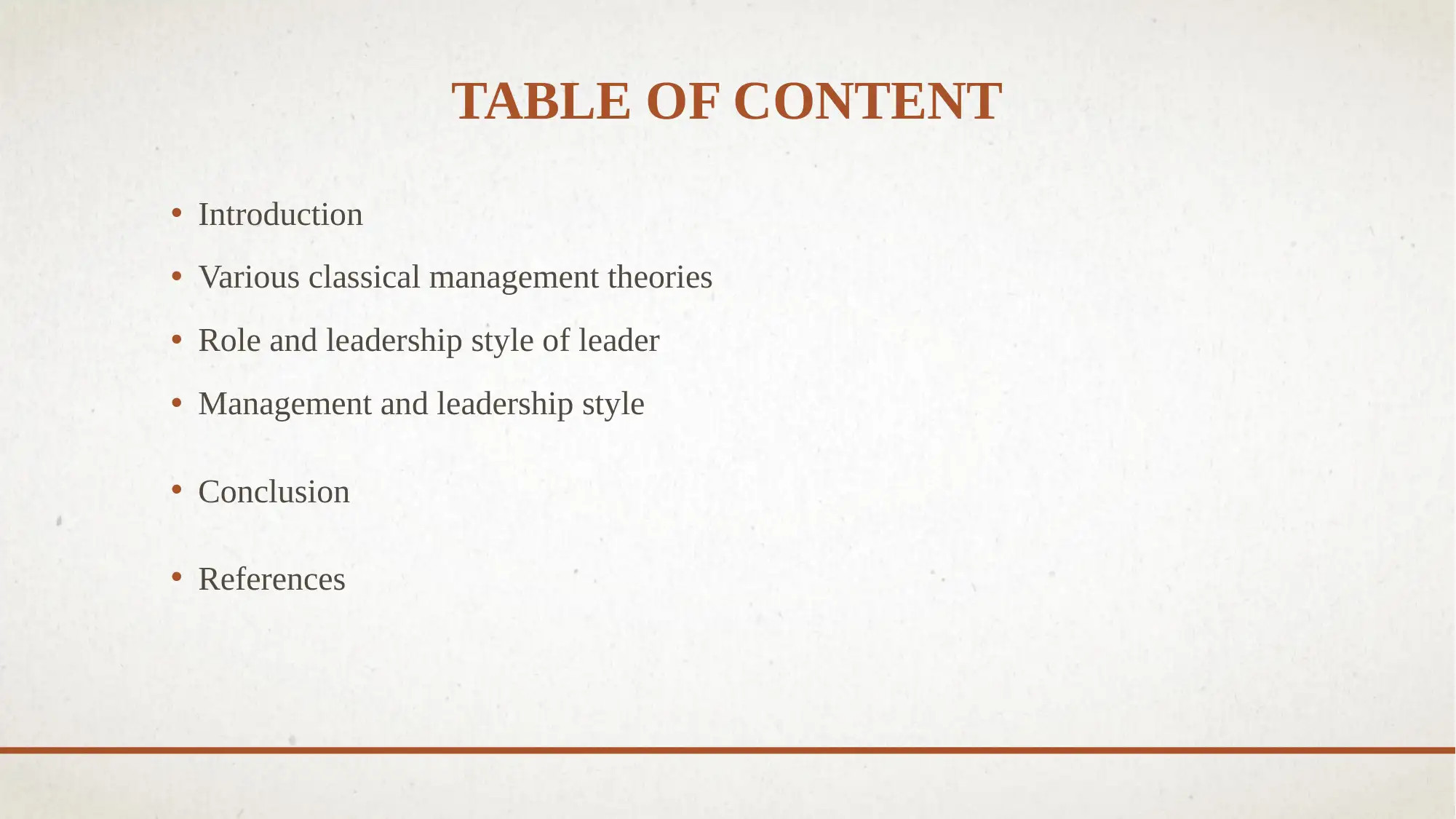
TABLE OF CONTENT
• Introduction
• Various classical management theories
• Role and leadership style of leader
• Management and leadership style
• Conclusion
• References
• Introduction
• Various classical management theories
• Role and leadership style of leader
• Management and leadership style
• Conclusion
• References
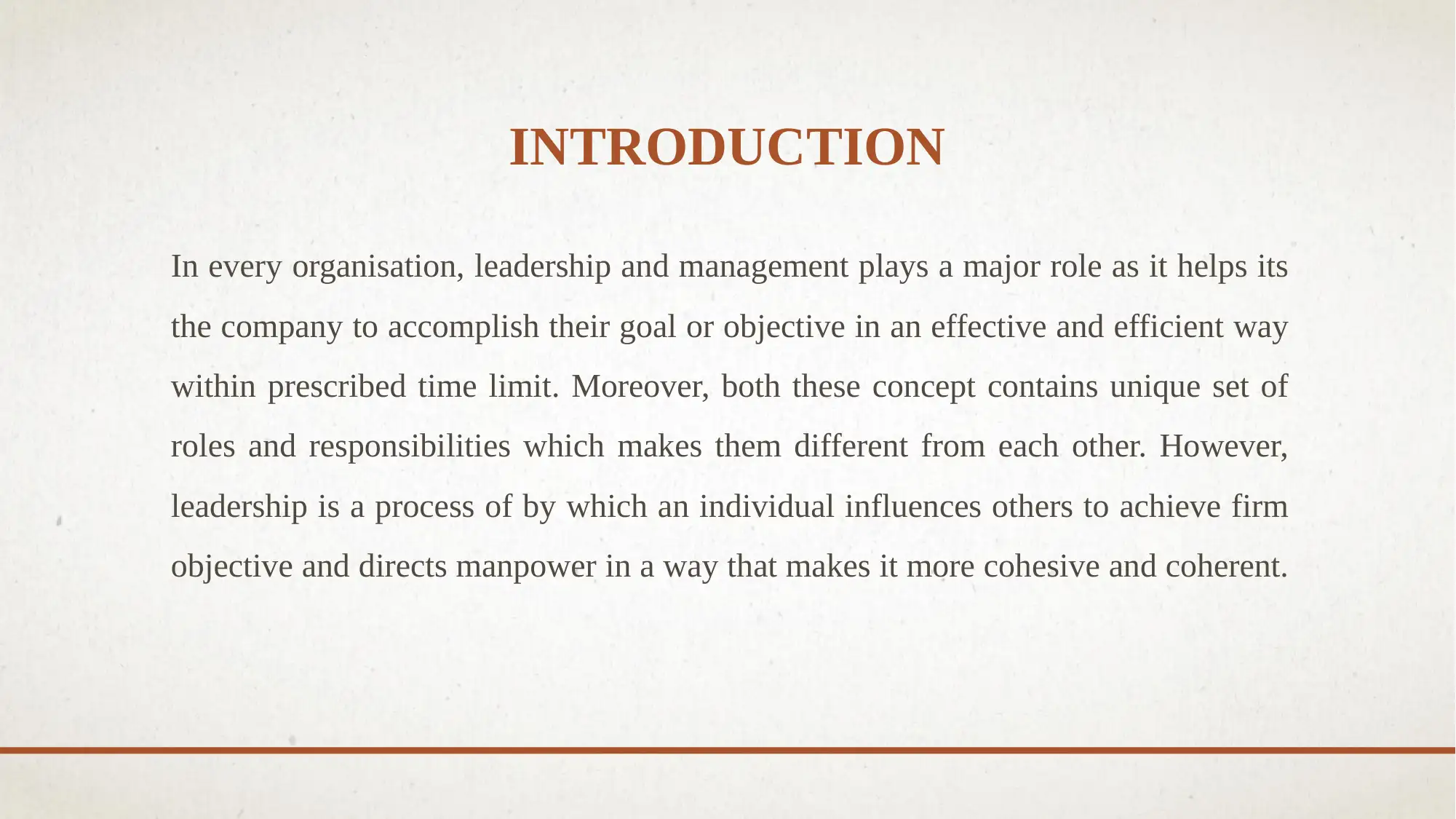
INTRODUCTION
In every organisation, leadership and management plays a major role as it helps its
the company to accomplish their goal or objective in an effective and efficient way
within prescribed time limit. Moreover, both these concept contains unique set of
roles and responsibilities which makes them different from each other. However,
leadership is a process of by which an individual influences others to achieve firm
objective and directs manpower in a way that makes it more cohesive and coherent.
In every organisation, leadership and management plays a major role as it helps its
the company to accomplish their goal or objective in an effective and efficient way
within prescribed time limit. Moreover, both these concept contains unique set of
roles and responsibilities which makes them different from each other. However,
leadership is a process of by which an individual influences others to achieve firm
objective and directs manpower in a way that makes it more cohesive and coherent.
⊘ This is a preview!⊘
Do you want full access?
Subscribe today to unlock all pages.

Trusted by 1+ million students worldwide
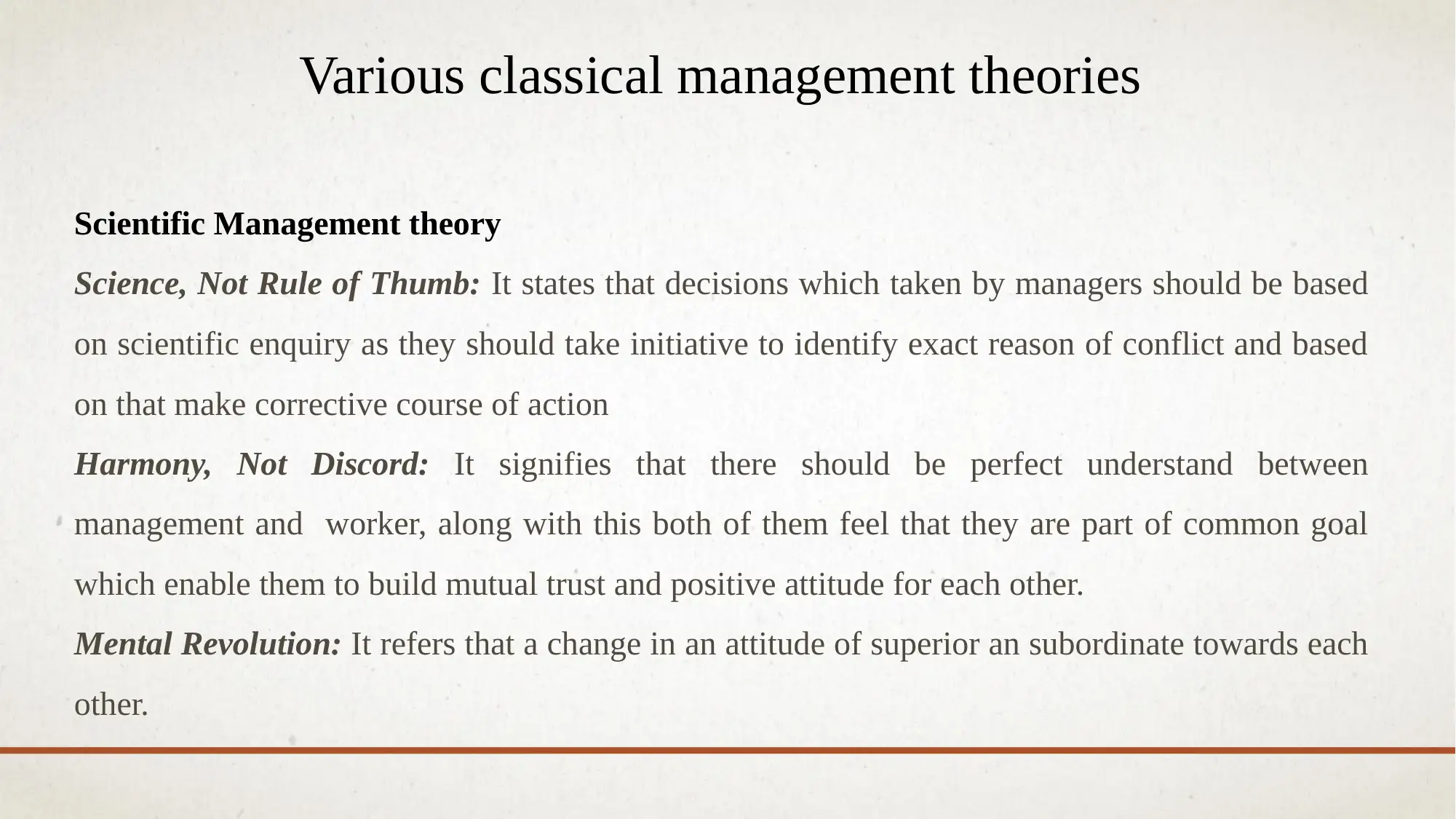
Various classical management theories
Scientific Management theory
Science, Not Rule of Thumb: It states that decisions which taken by managers should be based
on scientific enquiry as they should take initiative to identify exact reason of conflict and based
on that make corrective course of action
Harmony, Not Discord: It signifies that there should be perfect understand between
management and worker, along with this both of them feel that they are part of common goal
which enable them to build mutual trust and positive attitude for each other.
Mental Revolution: It refers that a change in an attitude of superior an subordinate towards each
other.
Scientific Management theory
Science, Not Rule of Thumb: It states that decisions which taken by managers should be based
on scientific enquiry as they should take initiative to identify exact reason of conflict and based
on that make corrective course of action
Harmony, Not Discord: It signifies that there should be perfect understand between
management and worker, along with this both of them feel that they are part of common goal
which enable them to build mutual trust and positive attitude for each other.
Mental Revolution: It refers that a change in an attitude of superior an subordinate towards each
other.
Paraphrase This Document
Need a fresh take? Get an instant paraphrase of this document with our AI Paraphraser
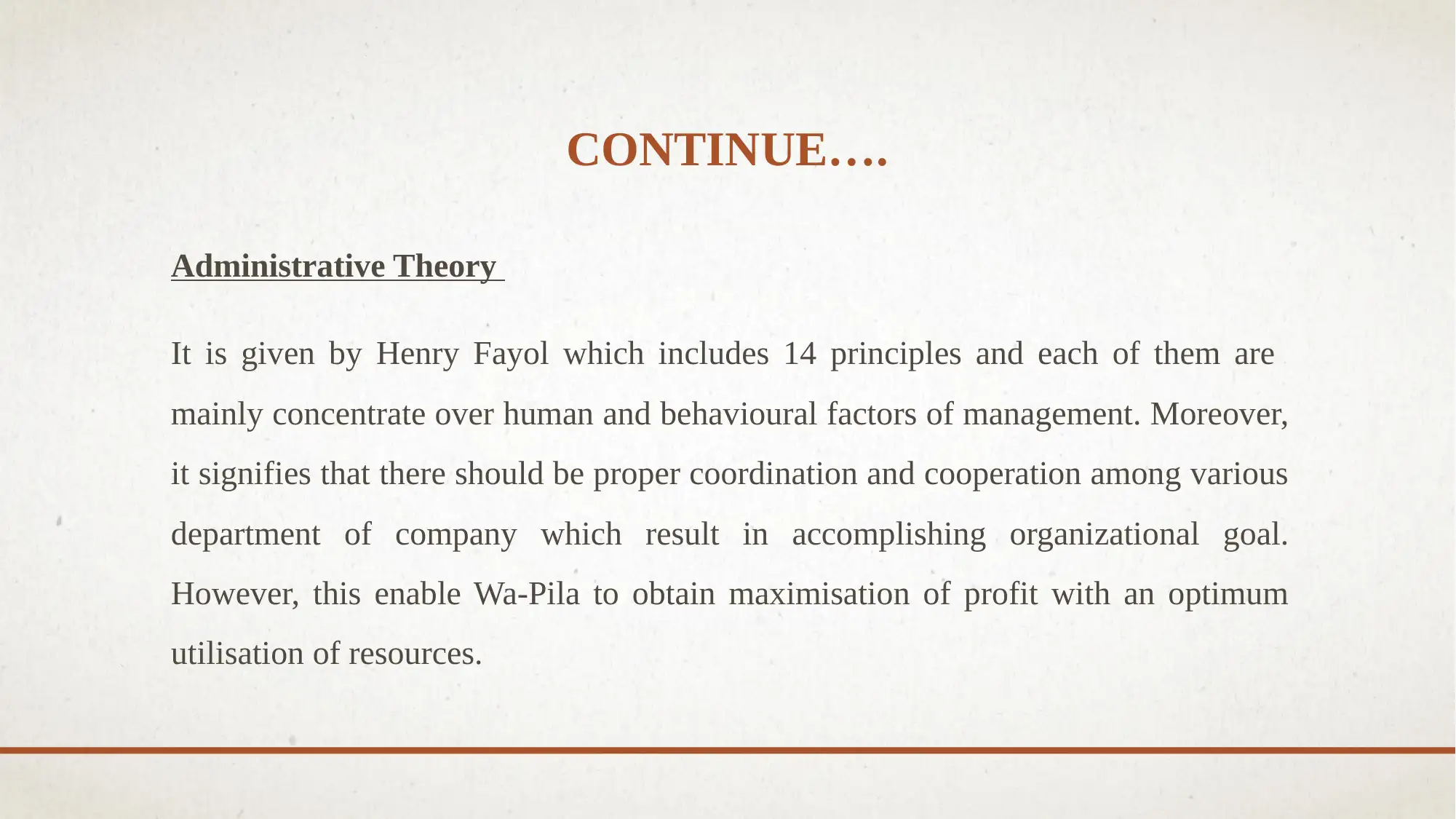
CONTINUE….
Administrative Theory
It is given by Henry Fayol which includes 14 principles and each of them are
mainly concentrate over human and behavioural factors of management. Moreover,
it signifies that there should be proper coordination and cooperation among various
department of company which result in accomplishing organizational goal.
However, this enable Wa-Pila to obtain maximisation of profit with an optimum
utilisation of resources.
Administrative Theory
It is given by Henry Fayol which includes 14 principles and each of them are
mainly concentrate over human and behavioural factors of management. Moreover,
it signifies that there should be proper coordination and cooperation among various
department of company which result in accomplishing organizational goal.
However, this enable Wa-Pila to obtain maximisation of profit with an optimum
utilisation of resources.
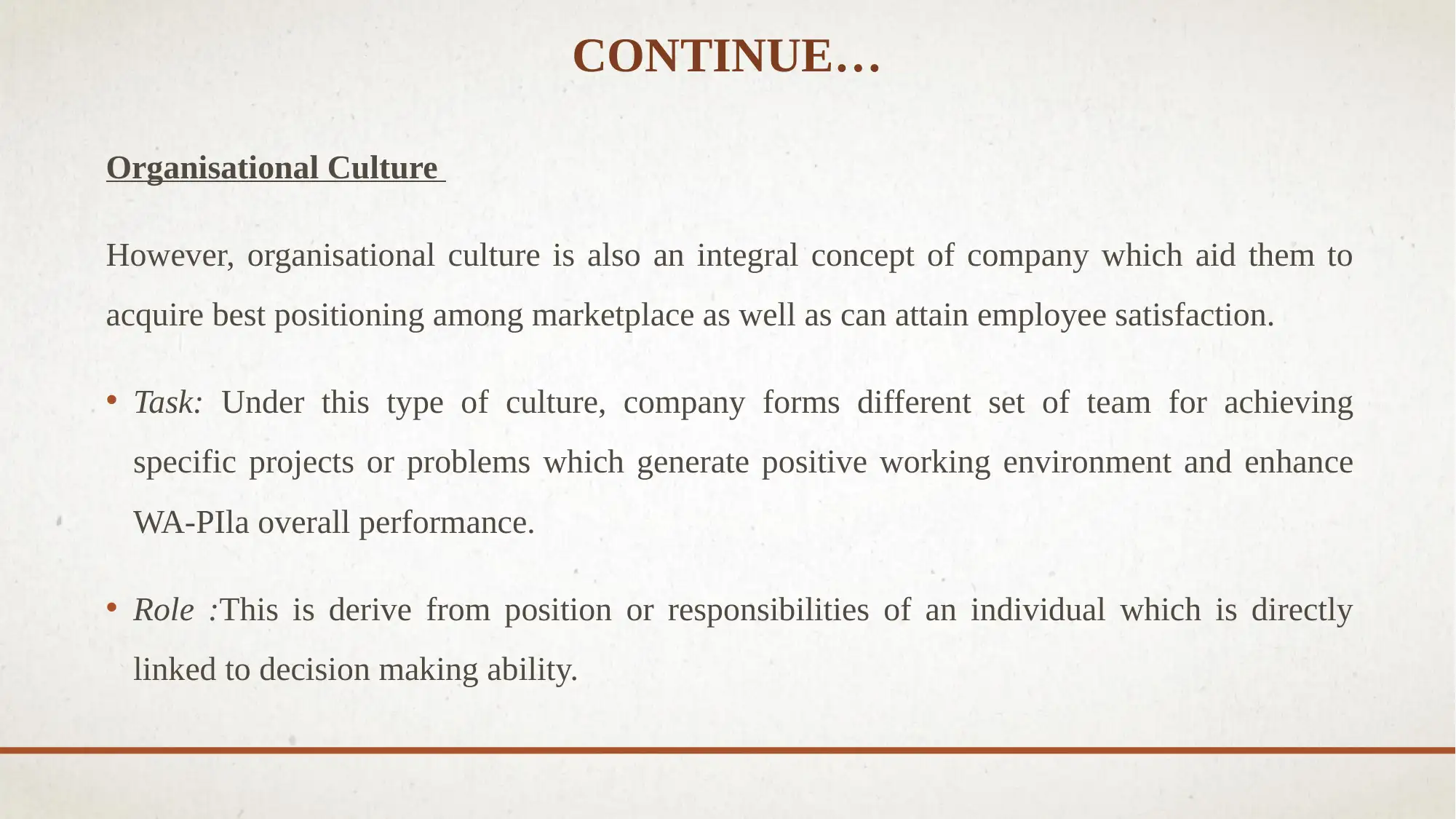
CONTINUE…
Organisational Culture
However, organisational culture is also an integral concept of company which aid them to
acquire best positioning among marketplace as well as can attain employee satisfaction.
• Task: Under this type of culture, company forms different set of team for achieving
specific projects or problems which generate positive working environment and enhance
WA-PIla overall performance.
• Role :This is derive from position or responsibilities of an individual which is directly
linked to decision making ability.
Organisational Culture
However, organisational culture is also an integral concept of company which aid them to
acquire best positioning among marketplace as well as can attain employee satisfaction.
• Task: Under this type of culture, company forms different set of team for achieving
specific projects or problems which generate positive working environment and enhance
WA-PIla overall performance.
• Role :This is derive from position or responsibilities of an individual which is directly
linked to decision making ability.
⊘ This is a preview!⊘
Do you want full access?
Subscribe today to unlock all pages.

Trusted by 1+ million students worldwide
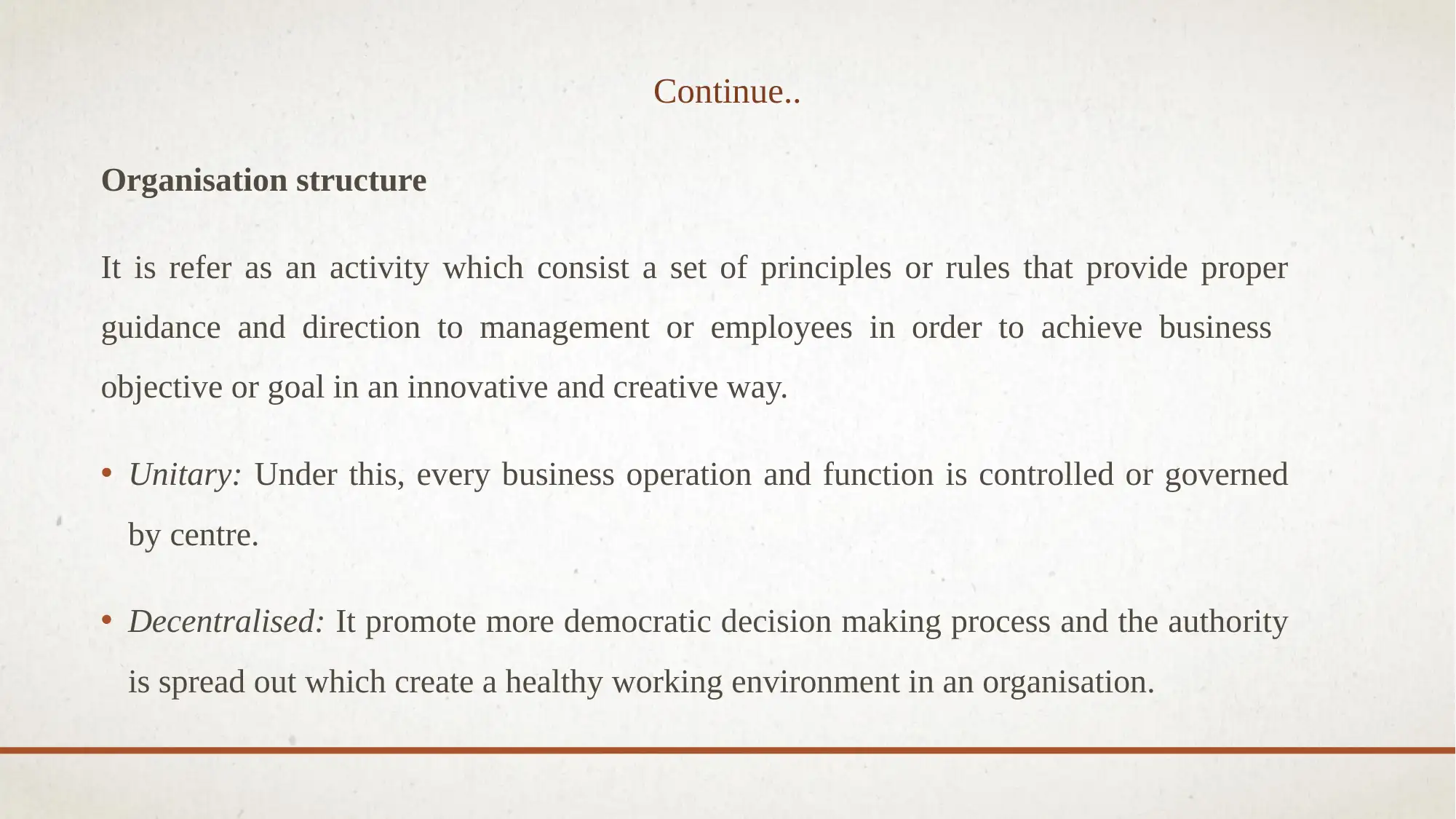
Continue..
Organisation structure
It is refer as an activity which consist a set of principles or rules that provide proper
guidance and direction to management or employees in order to achieve business
objective or goal in an innovative and creative way.
• Unitary: Under this, every business operation and function is controlled or governed
by centre.
• Decentralised: It promote more democratic decision making process and the authority
is spread out which create a healthy working environment in an organisation.
Organisation structure
It is refer as an activity which consist a set of principles or rules that provide proper
guidance and direction to management or employees in order to achieve business
objective or goal in an innovative and creative way.
• Unitary: Under this, every business operation and function is controlled or governed
by centre.
• Decentralised: It promote more democratic decision making process and the authority
is spread out which create a healthy working environment in an organisation.
Paraphrase This Document
Need a fresh take? Get an instant paraphrase of this document with our AI Paraphraser
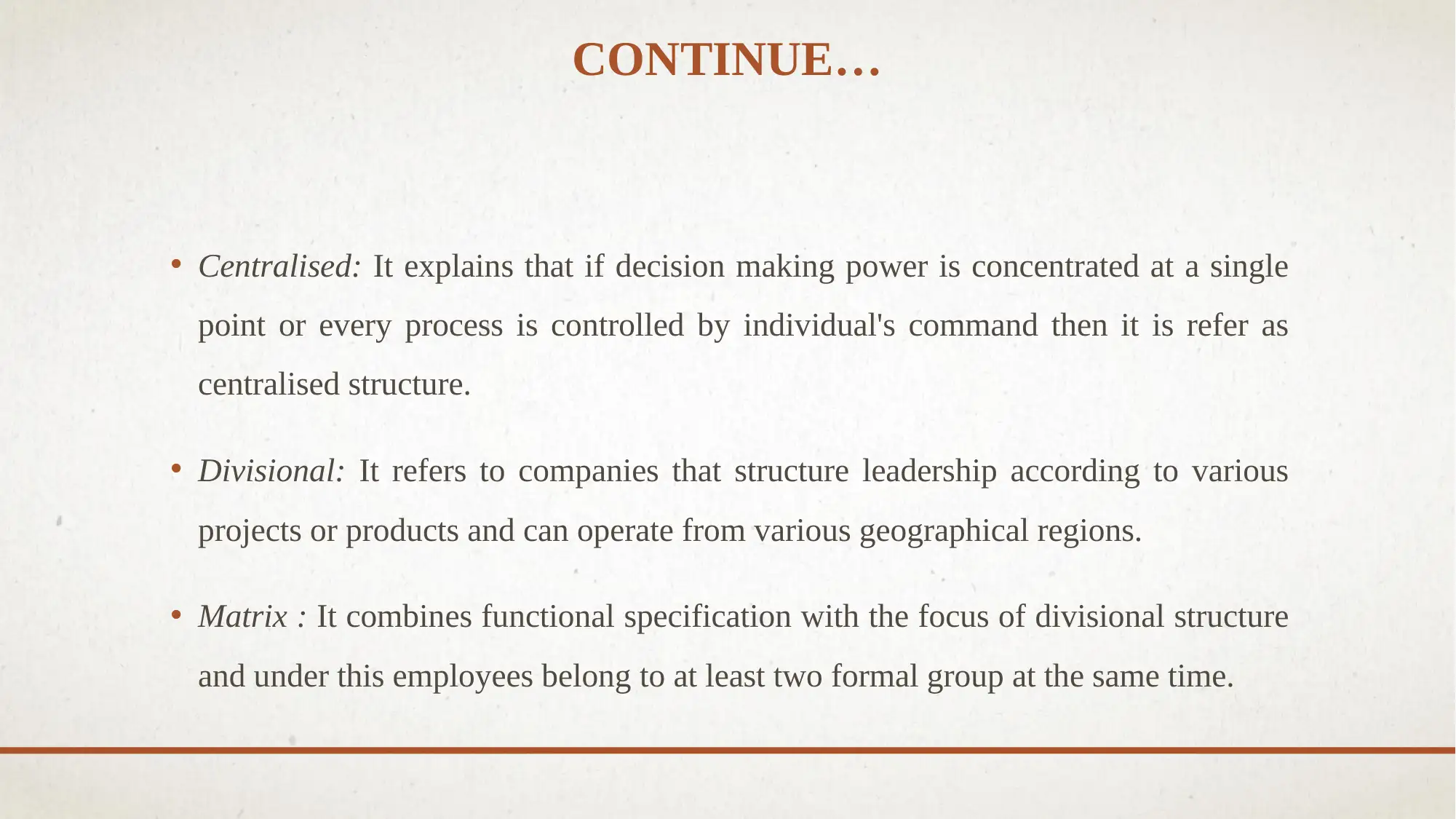
CONTINUE…
• Centralised: It explains that if decision making power is concentrated at a single
point or every process is controlled by individual's command then it is refer as
centralised structure.
• Divisional: It refers to companies that structure leadership according to various
projects or products and can operate from various geographical regions.
• Matrix : It combines functional specification with the focus of divisional structure
and under this employees belong to at least two formal group at the same time.
• Centralised: It explains that if decision making power is concentrated at a single
point or every process is controlled by individual's command then it is refer as
centralised structure.
• Divisional: It refers to companies that structure leadership according to various
projects or products and can operate from various geographical regions.
• Matrix : It combines functional specification with the focus of divisional structure
and under this employees belong to at least two formal group at the same time.
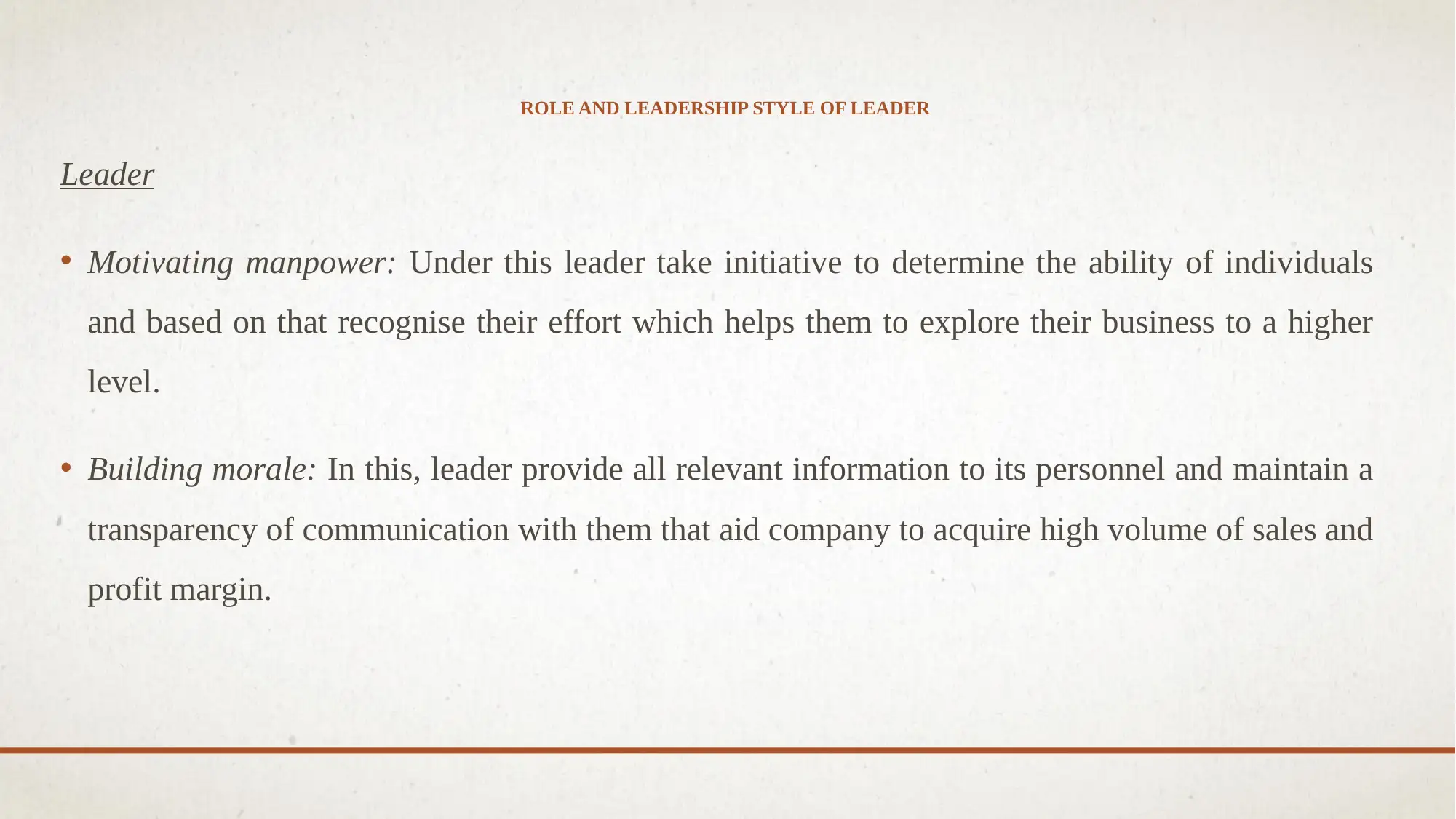
ROLE AND LEADERSHIP STYLE OF LEADER
Leader
• Motivating manpower: Under this leader take initiative to determine the ability of individuals
and based on that recognise their effort which helps them to explore their business to a higher
level.
• Building morale: In this, leader provide all relevant information to its personnel and maintain a
transparency of communication with them that aid company to acquire high volume of sales and
profit margin.
Leader
• Motivating manpower: Under this leader take initiative to determine the ability of individuals
and based on that recognise their effort which helps them to explore their business to a higher
level.
• Building morale: In this, leader provide all relevant information to its personnel and maintain a
transparency of communication with them that aid company to acquire high volume of sales and
profit margin.
⊘ This is a preview!⊘
Do you want full access?
Subscribe today to unlock all pages.

Trusted by 1+ million students worldwide
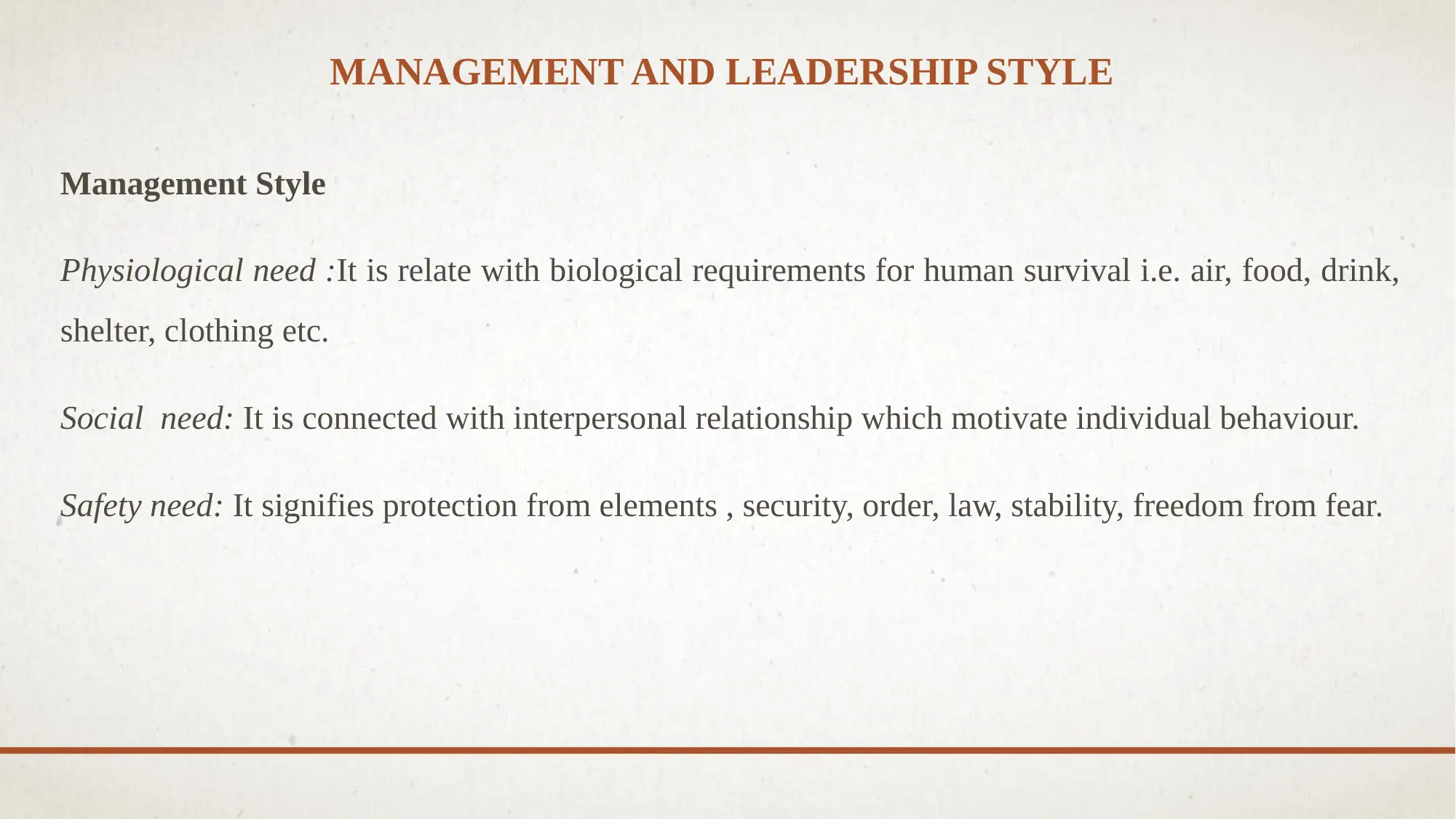
MANAGEMENT AND LEADERSHIP STYLE
Management Style
Physiological need :It is relate with biological requirements for human survival i.e. air, food, drink,
shelter, clothing etc.
Social need: It is connected with interpersonal relationship which motivate individual behaviour.
Safety need: It signifies protection from elements , security, order, law, stability, freedom from fear.
Management Style
Physiological need :It is relate with biological requirements for human survival i.e. air, food, drink,
shelter, clothing etc.
Social need: It is connected with interpersonal relationship which motivate individual behaviour.
Safety need: It signifies protection from elements , security, order, law, stability, freedom from fear.
Paraphrase This Document
Need a fresh take? Get an instant paraphrase of this document with our AI Paraphraser
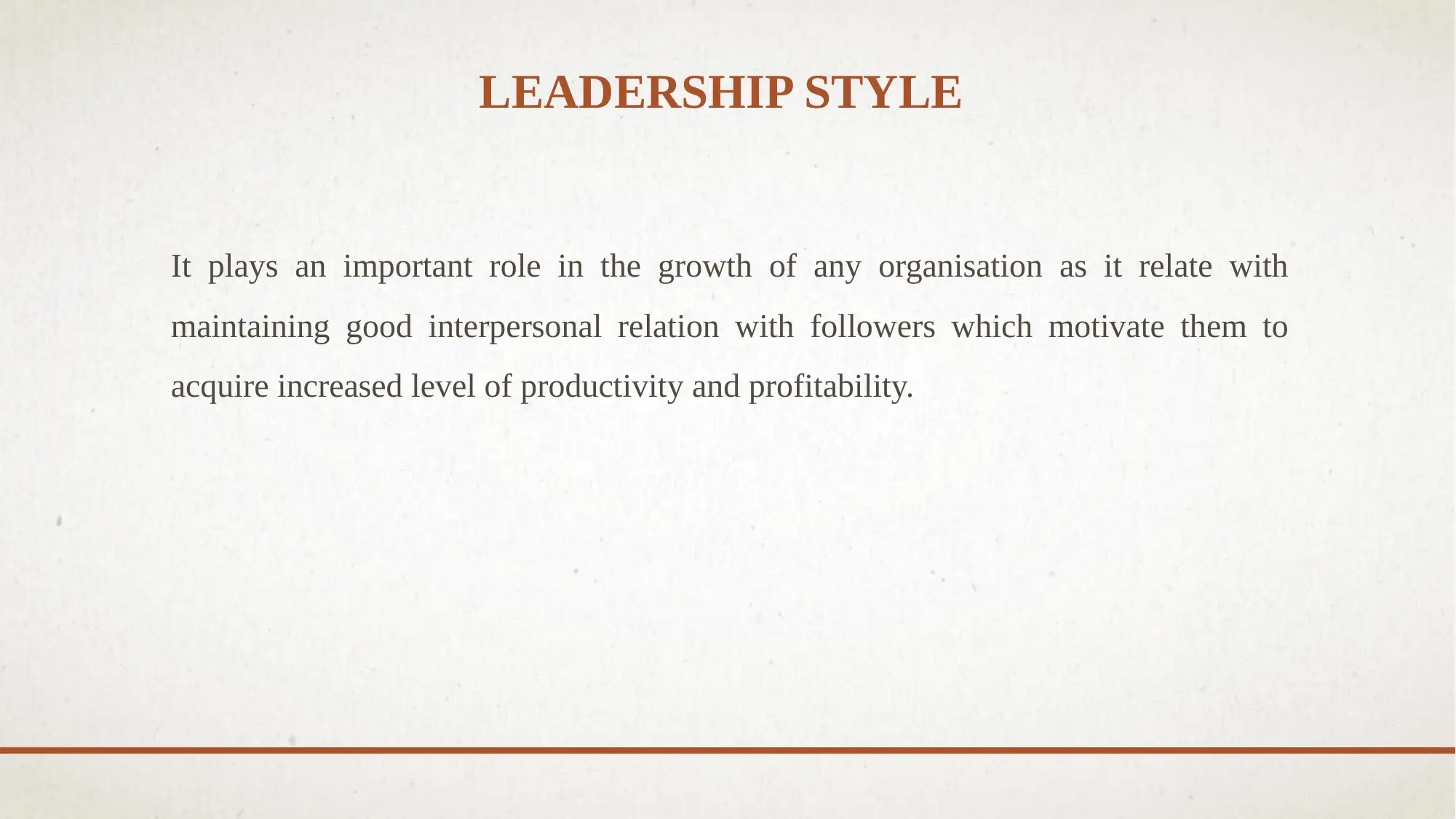
LEADERSHIP STYLE
It plays an important role in the growth of any organisation as it relate with
maintaining good interpersonal relation with followers which motivate them to
acquire increased level of productivity and profitability.
It plays an important role in the growth of any organisation as it relate with
maintaining good interpersonal relation with followers which motivate them to
acquire increased level of productivity and profitability.
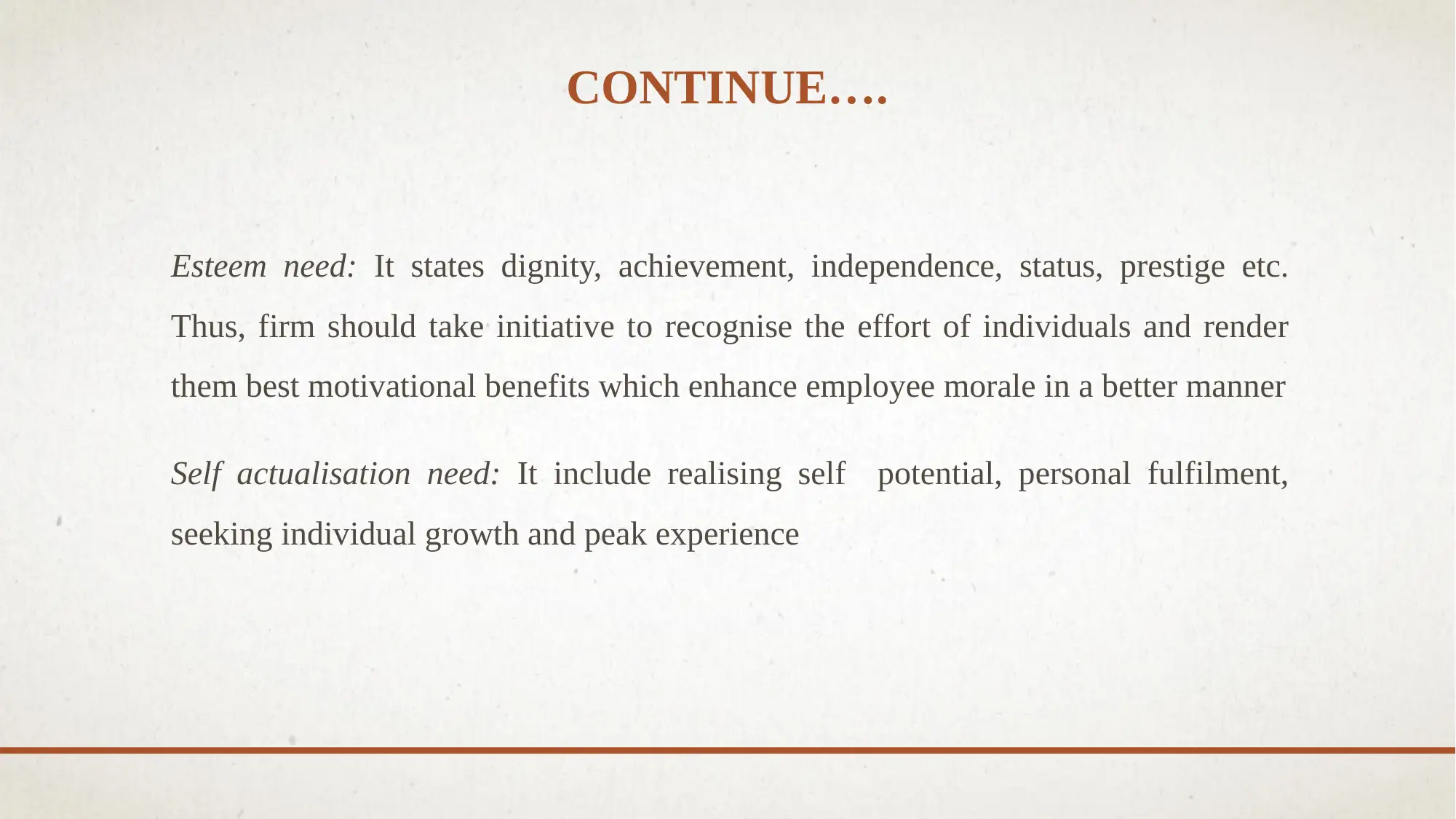
CONTINUE….
Esteem need: It states dignity, achievement, independence, status, prestige etc.
Thus, firm should take initiative to recognise the effort of individuals and render
them best motivational benefits which enhance employee morale in a better manner
Self actualisation need: It include realising self potential, personal fulfilment,
seeking individual growth and peak experience
Esteem need: It states dignity, achievement, independence, status, prestige etc.
Thus, firm should take initiative to recognise the effort of individuals and render
them best motivational benefits which enhance employee morale in a better manner
Self actualisation need: It include realising self potential, personal fulfilment,
seeking individual growth and peak experience
⊘ This is a preview!⊘
Do you want full access?
Subscribe today to unlock all pages.

Trusted by 1+ million students worldwide
1 out of 16
Related Documents
Your All-in-One AI-Powered Toolkit for Academic Success.
+13062052269
info@desklib.com
Available 24*7 on WhatsApp / Email
![[object Object]](/_next/static/media/star-bottom.7253800d.svg)
Unlock your academic potential
Copyright © 2020–2025 A2Z Services. All Rights Reserved. Developed and managed by ZUCOL.





